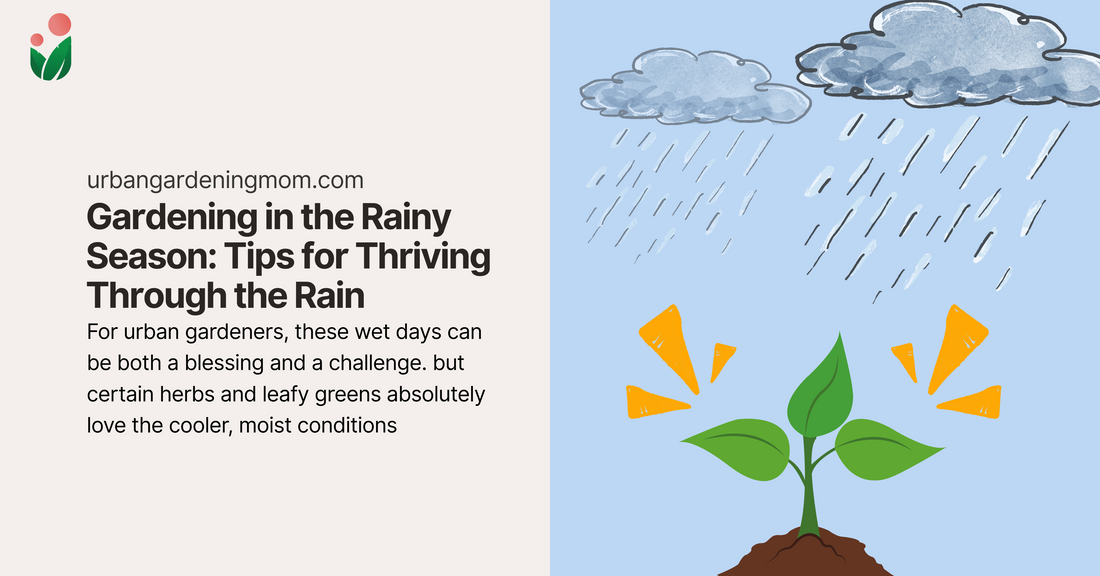
Gardening in the Rainy Season: Tips for Thriving Through the Rain
Share
The rainy season has arrived in the Philippines, and while some plants are thriving, others are struggling. For urban gardeners, these wet days can be both a blessing and a challenge. Afternoon downpours may limit outdoor activities, but certain herbs and leafy greens absolutely love the cooler, moist conditions.
If you're wondering how to keep your garden healthy and productive during this season, here are a few practical tips to guide you through.
---
1. Start Planting the Greens
Cool, wet weather is perfect for salad greens and Asian vegetables.
You’ll need:
- Seed trays
- Seeds (lettuce, spinach, pechay, kai-lan)
- Potting mix
- Sunny windowsill or indoor spot
How-to:
- Sow seeds every other week or alternate between 2–3 types weekly.
- Expect faster growth and harvest in about 6 weeks.
- Keep seed trays indoors to avoid root rot.
- Gradually move seedlings outdoors two weeks after germination.
Lesson: Timing your planting with the weather helps your greens thrive.
---
2. Ensure Proper Drainage for Potted Plants
Too much rain can drown sensitive roots.
You’ll need:
- Pots with drainage holes
- Drill (if adding extra holes)
- Well-draining soil
How-to:
- Check pots for proper drainage.
- Add more holes if water pools at the bottom.
- Avoid placing sensitive plants where rainwater collects.
Lesson: Healthy roots need air and space — not soggy soil.
---
3. Replenish Soil Nutrients
Rain can wash away essential nutrients.
You’ll need:
- Organic fertilizer or compost
- Small garden tool for loosening soil
How-to:
- Loosen hardened soil before applying fertilizer.
- Place fertilizer around the plant’s base, near the leaf tips.
- Reapply after heavy rains to maintain soil health.
Lesson: Nourish your soil to keep your plants strong and resilient.
---
4. Watch Out for Pests and Diseases
Wet weather invites unwanted visitors.
You’ll need:
- Morning inspection routine
- Organic pest control (optional)
How-to:
- Check plants daily for slugs and crawling pests.
- Remove infected plants immediately to prevent spread.
- Avoid reusing soil from diseased crops.
Lesson: A little vigilance goes a long way in protecting your garden.
---
5. Move Sensitive Plants Like Rosemary
Some herbs don’t like getting soaked.
You’ll need:
- Covered area with sunlight
- Stable pot placement
How-to:
- Move rosemary, lavender, and aloe vera indoors or under a shed.
- Ensure they still receive consistent sunlight.
- Avoid frequent repositioning — rosemary dislikes sudden light changes.
Lesson: Sensitive plants need stability, especially during seasonal shifts.
---
6. Protect Yourself While Gardening
Gardening is still joyful — just stay safe.
You’ll need:
- Lightweight raincoat
- Gardening boots
- Daily vitamins
How-to:
- Choose a raincoat that allows airflow and movement.
- Wear boots to avoid muddy puddles and slippery paths.
- Boost your immunity with vitamins after exposure to rain.
Lesson: A healthy gardener grows a healthy garden.
---
Rainy Days, Rooted Joy
Gardening during the rainy season may require a few adjustments, but it’s still a beautiful way to connect with nature. From planting greens to protecting your rosemary, each step helps your garden adapt and thrive. And don’t forget — your well-being matters too.
Happy gardening!
